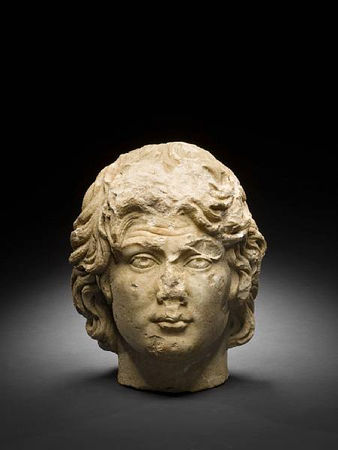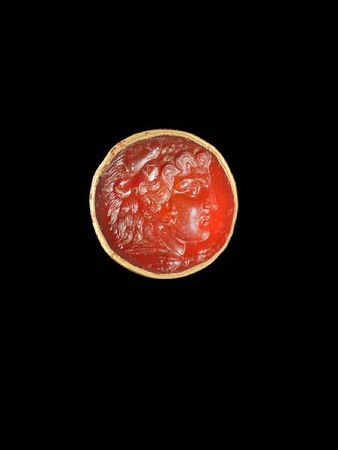Three Images of Alexander the Great in Sculpture and Jewellery @ Bonhams Antiquities Sale
A Roman marble head of Alexander the Great. Antonine, circa A.D. 138-161
Bonhams yesterday sale of Antiquities on April 13thincludes three powerful images of Alexander the Great - a 2000-year-old ring bearing his image and two stunning sculpted heads from the same era.
Madeleine Perridge, Head of Antiquities at Bonhams comments: "Alexander has been seen as the greatest general and ruler in history. After his death he was treated as a demi-god, his image was everywhere and his legendary exploits a powerful part of Greek and Roman culture. The Roman emperors even adopted him as an ideal and represented themselves in his guise – A ring used by the emperor Augustus was actually adorned with the figure of Alexander, possibly much like the one we are selling. The three works of art up for auction are proof of the power of his image and legend throughout the Hellenistic and Roman periods, enduring even in the present day."
The first sculpted head of Alexander the Great is Roman from the Antonine dynasty, circa A.D. 138-161, it is over-lifesize. He is depicted with distinctive wavy hair falling at his furrowed brow and the nape of his neck, his brows carved in relief with notched details, the lidded eyes with incised irises and drilled pupils, his shapely lips above a strong chin. It stands 12½in (31.7cm) high, and is estimated to sell for £150,000-200,000.
Clearly identifying this marble head as a portrait of Alexander the Great (366-323 B.C.) are his characteristic idealized facial features and distinctive "anastolé" hairstyle, with a wavelike formation of locks over the forehead.
Although a number of images of Alexander were made during his lifetime, most of these Greek originals have not survived. The vast majority of his portraits that have come down to us are Graeco-Roman copies, adaptations, and transformations in all media (bronze and marble sculptures, paintings, mosaics, coins, gemstones) that reflected lost Greek originals. These Graeco-Roman images were produced throughout Rome's empire from about the 2nd Century B.C. until late Roman antiquity because Alexander had captured the imagination of Rome's great military men and statesmen, who wished to emulate Alexander and his deeds in one way or another.
Some of Alexander's original portraits were even brought back to Rome to adorn the city. There are many examples of Alexander's image being recalled by Rome's leaders including Pompey, Julius Caesar and Caligula who was said to have worn a breastplate that once belonged to Alexander. Other emperors, too, imitated or emulated Alexander in various ways.
A Roman marble head of Alexander the Great. Antonine, circa A.D. 138-161. Photo Bonhams
Over life-size, depicted with distinctive wavy hair falling at his furrowed brow and the nape of his neck, his brows carved in relief with notched details, the lidded eyes with incised irises and drilled pupils, his shapely lips above a strong chin, 12½in (31.7cm) high. Estimate: £120,000 - 150,000, € 140,000 - 170,000, $ 190,000 - 240,000. Unsold
Provenance:: American private collection, San Francisco, since the 1960s.
Literature:: Clearly identifying this marble head as a portrait of Alexander the Great (366-323 B.C.) are his characteristic idealised facial features and distinctive "anastolé" hairstyle, with a wavelike formation of locks over the forehead. For the portraiture of Alexander in general, see M. Bieber, Alexander the Great in Greek and Roman Art, Chicago, 1964; J. Carlsen et al. (edd.), Alexander the Great: Reality and Myth, Rome, 1993; A. Stewart, Faces of Power: Alexander's Image and Hellenistic Politics, Berkeley, 1993; P.Moreno, Alessandro Magno: Immagini come storia, Rome, 2004.
Although a number of images of Alexander were made during his lifetime, most of these Greek originals have not survived. The vast majority of his portraits that have come down to us are Graeco-Roman copies, adaptations, and transformations in all media (bronze and marble sculptures, paintings, mosaics, coins, gemstones) that reflected lost Greek originals. These Graeco-Roman images were produced throughout Rome's empire from about the 2nd Century B.C. until late Roman antiquity, as evidenced in a 4th Century A.D. portrait of Alexander from Aphrodisias (Turkey): See R.R.R. Smith, 'Late Roman Philosopher portraits from Aphrodisias', JRS, 80, 1990, 135-38, pls.VIII-IX.
A great many of these images were produced in the Roman period because Alexander had captured the imagination of Rome's great military men and statesmen, who wished to emulate Alexander and his deeds in one way or another. Some of Alexander's original portraits were even brought back to Rome to adorn the city. There are many examples of Alexander's image being recalled by Rome's leaders. To celebrate his victory over the Macedonians, the Roman general Metellus Macedonicus set up in a sanctuary in Rome in 148 B.C. a whole group of bronze equestrian figures by Lysippos representing Alexander and his companions that had originally been set up at Dion in Macedonia to commemorate Alexander's defeat of the Persians at the Granikos River in 334 B.C.
Pompey, who was called Magnus ("the Great") in an implied reference to Alexander the Great, even recalled somewhat in his own hairstyle Alexander's distinctive anastolé hairdo. Julius Caesar brought back from Greece a famous bronzed equestrian statue of Alexander by Lysippos, which was set up in Caesar's forum in Rome, only with Caesar's head replacing that of Alexander to suggest that Caesar was now the "New Alexander." After the fall of Alexandria in 30 B.C., Octavian (Augustus Caesar) visited the Tomb of Alexander and used a signet ring with Alexander's portrait engraved on it. Octavian also brought back paintings of Alexander by Alexander's court painter Apelles that were displayed in his forum in Rome. A Greek inscription from the 2nd Century A.D. from Ephesos in Asia Minor testifies to the continued worship of Alexander along with Augustus' adopted sons and intended successors Gaius and Lucius in the context of the Roman imperial cult. Caligula was said to have worn a breastplate that once belonged to Alexander. Other emperors, too, imitated or emulated Alexander in various ways.
This portrait of Alexander was also created in the Roman period, most likely at the time of the emperor Antoninus Pius (A.D. 138-161) based on stylistic considerations, which include the incising of the irises and the large shallow bore-hole in the pupils of the eyes, as well as the deeply undercut long hairlocks. Incising the irises and boring pupils became popular in the late Hadrianic period (circa A.D. 130), while rough or schematic drilling of the hairlocks sometimes with small struts left between the individual drill channels was characteristic at the time of Antoninus' successor Marcus Aurelius (A.D. 161-180). In this portrait the hair is still treated plastically rather than schematically.
Although the structure and form of this Alexander with its strong frontal emphasis recalls Late Classical models like a head of Alexander in the Athens Acropolis Museum, (A. Stewart, Faces of Power: Alexander's Image and Hellenistic Politics, Berkeley, 1993, pp.106-112, fig. 5.), the expressive face with deeply furrowed brow has more in common with such Hellenistic baroque types as the head of Alexander from Pergamon in the Istanbul Archaeological Museum (Stewart, pp.332-33, figs.128-129).
The artistic style of this Alexander is in keeping with 2nd Century sculptures of the Greek East, especially of Greece. A particularly close stylistic parallel that dates our head to mid-2nd Century A.D. is a portrait of Antoninus Pius from Olympia (Greece): M. Wegner, Die Herrscherbildnisse in antonischer Zeit, 1939, p.136, pl.9b.
The second Alexander in this sale is once again a Roman marble head of Alexander Helios Circa 1st Century B.C.-A.D. The thick wavy hair secured with a fillet with two lines of drill holes for insertion of the radiate headdress, the head tilted slightly to the right, with deep-set almond-shaped eyes and full lips, 7¾in (20cm) high. It is estimated to sell for £7,000-9,000.
This piece was acquired by John Peter Deering, an eminent architect and Royal Academician of the early 19th Century, probably on a trip to Pompeii circa 1817. He also co-wrote with Sir William Gell, an account of his trip to Pompeii: "The Topography, Edifices and Ornaments of Pompeii".
A Roman marble head of Alexander Helios. Circa 1st Century B.C.-A.D. Photo Bonhams
The thick wavy hair secured with a fillet with two lines of drill holes for insertion of the radiate headdress, the head tilted slightly to the right, with deep-set almond-shaped eyes and full lips, 7¾in (20cm) high, mounted
Provenance:: English private collection, acquired in the early 19th Century and thence by descent.
This piece was acquired by John Peter (Gandy) Deering, an eminent architect and Royal Academician of the early 19th Century, probably on a trip to Pompeii circa 1817. That year he co-wrote with Sir William Gell, an account of his trip to Pompeii: The Topography, Edifices and Ornaments of Pompeii, the third edition published by Henry G. Bohn, London, in 1852.
An Attic marble relief from Rhamnous was also in the family home in Upper Norwood in south London, until it was bombed during World War II, when it was then donated to the British Museum to join the head of the cult statue of Nemesis from Rhamnous he had donated earlier. Cf. B. Ashmole, 'Torch-Racing at Rhamnus', AJA, vol. 66, no. 3, July, 1962, pp. 233-234. This lot is accompanied by a copy of an article from The Times dated to circa 1952, which discusses John Peter Deering and the Rhamnous relief, which for a time was thought to have come from Pompeii too.
The third Alexander-linked object in the sale is a Hellenistic gold and carnelian intaglio ring of Alexander the Great Circa 2nd-1st Century B.C.. A flat circular stone engraved with a profile head of Alexander the Great in the guise of Herakles wearing the lion's skin, the jaws pulled up over his head with the paws tied at the neck, set in the original gold ring, the hoop flaring at the bezel. It is estimated to sell for £40,000-50,000.
A Hellenistic gold and carnelian intaglio ring of Alexander the Great. Circa 2nd-1st Century B.C. Photo Bonhams
Literature:: For similar intaglios of Alexander, cf. D. Plantzos, Hellenistic Engraved Gems, Oxford, 1999.
Bonhams.. Antiquities including Property from the Collection of Sir Daniel Donohue, 13 Apr 2011, New Bond Street www.bonhams.com

/https%3A%2F%2Fprofilepics.canalblog.com%2Fprofilepics%2F1%2F0%2F100183.jpg)







/http%3A%2F%2Fstorage.canalblog.com%2F47%2F30%2F119589%2F62190808_p.jpg)
/http%3A%2F%2Fstorage.canalblog.com%2F43%2F06%2F577050%2F55458132_o.jpg)
/http%3A%2F%2Fstorage.canalblog.com%2F98%2F85%2F577050%2F52429542_o.jpg)
/http%3A%2F%2Fstorage.canalblog.com%2F11%2F33%2F119589%2F38758287_p.jpg)